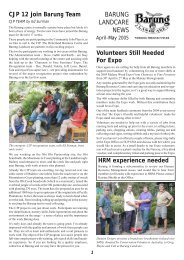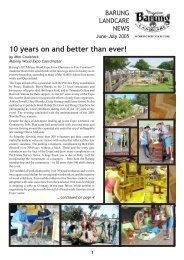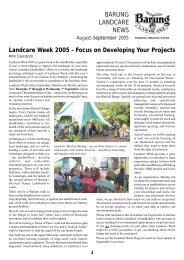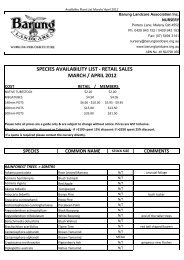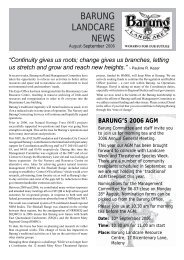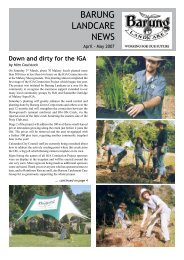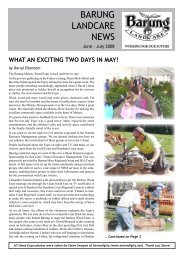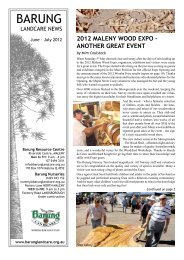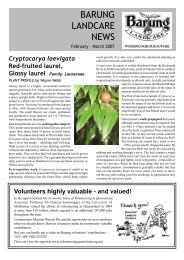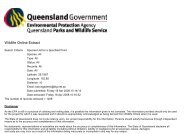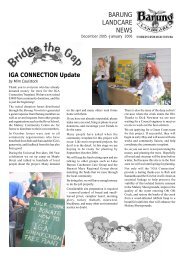Jun/Jul 2010 - Barung Landcare
Jun/Jul 2010 - Barung Landcare
Jun/Jul 2010 - Barung Landcare
Create successful ePaper yourself
Turn your PDF publications into a flip-book with our unique Google optimized e-Paper software.
ORANGE BRACKET<br />
FUNGAL FORAY by Gretchen Evans<br />
Orange Bracket Pycnoporus coccineus is a widespread wooddecaying<br />
fungus which is found throughout Australia.<br />
Apparently it likes an open habitat and can be found in many<br />
different types of vegetation such as eucalypt forests, tidal mangroves<br />
and sandy deserts in central Australia. It is not so common<br />
in rainforests. I have seen it growing on dry dead twigs and logs<br />
on a variety of plants such<br />
as wattles, sheoaks, banksias<br />
and even prunings from my<br />
peach tree.<br />
It is a fan-shaped bracket<br />
fungus easily seen by its bright<br />
orange colour which fades in<br />
time to white or sometimes<br />
looks greenish due to the<br />
growth of algae.<br />
It belongs to a group of fungi<br />
which have pores underneath.<br />
Pycnoporus coccineus, showing the tiny pores on the<br />
undersurface (left) and the under (above left) and<br />
upper surfaces (above right). [Photos by Frances Guard]<br />
Pycno porus means ‘dense pores’ and coccineus is ‘scarlet’.<br />
Orange Bracket is said to contain two antibiotics and was used in<br />
the past by Aboriginal people to treat various ailments.<br />
BOOKS FOR SALE<br />
at the BARUNG BOOKSHOP, Riverside Centre, Maleny<br />
Australian Stingless Bees:<br />
A Guide to Sugarbag Keeping<br />
John Klumpp (2007)<br />
Endorsed by the Australian Native Bee Research Centre, this<br />
is a valuable handbook for anyone interested in keeping our<br />
native honeybees.<br />
These tiny native bees, fascinating for<br />
young and old, can be kept safely and<br />
easily throughout warm areas of Australia.<br />
This detailed, easy-to-read book<br />
guides you through all aspects of the<br />
hobby, from finding or buying a nest,<br />
bee behaviour and life cycle, creating<br />
a bee friendly garden to building<br />
your own hive. It is filled with good<br />
quality colour photographs, a glossary,<br />
a register of stingless beehives<br />
in public places, a list of contacts<br />
and resources and a good index. The<br />
author is one of Australia’s most<br />
creative and talented stingless bee keepers and<br />
beginners will enjoy his informal style yet this book is factual<br />
and informative enough to expand the knowledge of even experienced<br />
beekeepers. Soft cover. $35.<br />
Subtropical Rainforest Restoration<br />
Big Scrub Rainforest <strong>Landcare</strong> Group (2005)<br />
This is a practical manual and data<br />
source for landcare groups, land<br />
managers and rainforest regenerators.<br />
The contents include a<br />
section on the different types<br />
rainforests, seed dispersal and<br />
sources, remnant rehabilitation<br />
and a section of special interest<br />
to our hinterland area – converting<br />
camphor laurel forest to<br />
rainforest.<br />
This book also covers the<br />
important aspects of rainforest<br />
planning, planting and<br />
weed control. It has a glossary,<br />
bibliography, suggested<br />
further reading and twelve appendices, including<br />
seed collection and propagation and a species planting guide. It<br />
also lists sources of assistance for rainforest restoration projects<br />
including how to write a good funding application.<br />
It is soft cover, spiral bound, with line drawings and priced at<br />
just $29.<br />
BEE the way…: Robert Luttrell, also known as ‘Bob the<br />
Beeman’, has the delicious fruity sugarbag honey for sale<br />
in small quantities. Contact him on 07 3289 5553 or email<br />
robertb.luttrell@bigpond.com.<br />
Bob’s website www.rovingphotos.com.au is mainly set up<br />
for people to contact Bob if they find a stingless bee hive that<br />
needs to be relocated – in a downed tree, for instance. Bob has<br />
some interesting ideas for the culinary use of sugarbag honey.<br />
9



